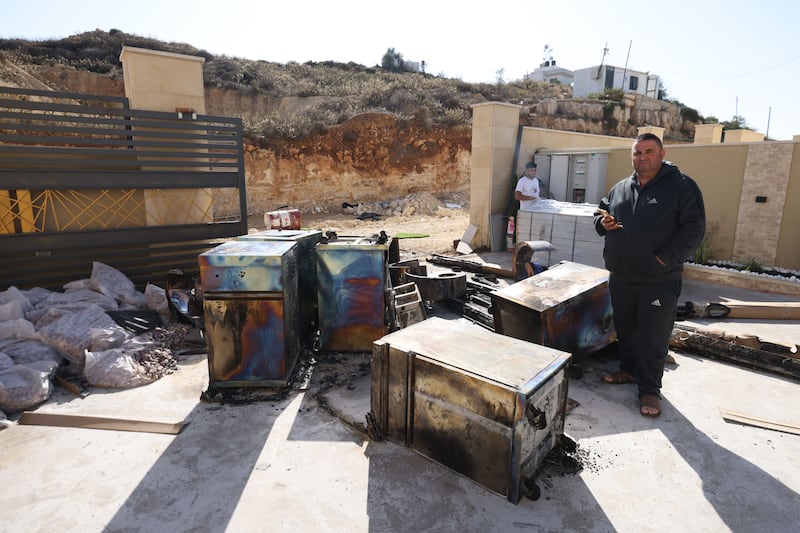Property investment manager John Bruder is sitting in an apartment above the Frascati shopping centre in Blackrock, south Dublin looking out at the Irish Sea. It’s one of 45 that have been built over the centre, which his company Gresham House manages on behalf of Invesco Real Estate. As far as Bruder is concerned, this five-storey mix of shopping and apartments is a model for modern city living, and should be copied elsewhere.
When Invesco bought the Frascati from the Roche family in 2015, it had a Debenhams and about half a dozen small shops. “The key point we identified was that it’s a site of about seven acres in the centre of Blackrock, and 75 per cent of it was used for parking cars on tarmac,” Bruder says. “Therein lay what we thought was a commercial opportunity: utilise the development potential, and play into the keenly-promoted planning policy of densification of existing urban land.”
The renovation of the shopping centre is almost complete, with Home Store & More’s imminent opening the last piece of the jigsaw. Phases two and three of the residential development will add 120 apartments to the 45 already there, but the planning file has been stuck in An Bord Pleanála (ABP) for a year, part of an enormous backlog.
“We are getting more and more agitated about being kept waiting, and we are a microcosm of what’s happening countrywide for the industry,” he says. “All those planning decisions that have not been made since last summer will lead to non-developing of projects, that won’t get built or started, from the middle of this year.”
READ MORE
In those days, most development in Ireland was cheap and shoddy. Developers typically built as cheaply as they possibly could
His solution? Hire planners, short-term, from outside Ireland. “It is a question of resourcing ABP with new board members and professional planners. The planning community in Ireland is quite small, and the existing public-service planners are already fully utilised. Private-sector planners are invariably involved with development clients. So, to my mind, the answer is that you second in planners from outside the jurisdiction, who have no potential conflicts.”
There have been many schemes and tax incentives aimed at persuading us to “live over the shop”. It’s something Ireland did quite happily until the 1980s, especially in rural towns. “I lived for the first two years of my life over a shop in Portlaoise,” Bruder says. “It was the norm. But as a country we became entranced by the American model, of not only suburban shopping centres but the suburban lifestyle.
“Johnny Ronan developed a couple of very fine apartments on Grafton Street, which he still owns, and that was one of the earliest examples I have come across of a successful development involving living over the shop. Johnny has many critics for many reasons, but one of the things he is good at is innovative thinking, taking the best of ideas from other cities around the world, and bringing them to Dublin.”
Frascati could be described as a 21st-century version of living over the shop, and Bruder says other shopping centres could be developed in similar fashion. “Many of those created in the 1970s, 1980s and 1990s are struggling, because retail has evolved, but they are located in key central locations and are well capable of providing a wider mix,” he argues.
I lived for the first two years of my life over a shop in Portlaoise. It was the norm. But as a country we became entranced by the American model
The Blackrock shopping centre doesn’t just offer a token coffee shop, it has restaurants; there’s not just a hairdresser and barber, there’s a health and beauty corner – “Here you can get anything from a Botox to having your nails painted, male or female, to dentists,” Bruder boasts. “That mix-and-match goes back to the traditional notion of the old main street, which was not just shopping, but rather the centre of the community.”
Bruder is surprised this sort of development hasn’t happened sooner in Ireland, as it has elsewhere in Europe. “Hammerson, which co-owns Dundrum shopping centre, is currently going through a planning process for quite a large residential scheme there, so other shopping centre investors and developers are looking at the idea, but I think Frascati is the first.”
Frascati’s mix-and-match goes back to the traditional notion of the old main street, which was not just shopping, but rather the centre of the community
The 64-year-old was with Treasury Holdings for 12 years, and is still proud of what was achieved by one of the flagship developers of the Celtic Tiger era. “We developed some of the finest buildings in Dublin – the Convention Centre is a landmark now; that was a derelict freight yard when I joined Treasury Holdings,” he says. “Beside that [in Dublin’s docklands] is the PwC head office. Then there’s the old Bank of Ireland head office in Burlington Road, Central Park in Leopardstown, the Westin hotel – a heap of fine investment properties which have stood the test of time.”
So why did Treasury end up “hopelessly insolvent”? The company founded by Johnny Ronan and Richard Barrett eventually owed €2.7 billion, over half of it to State agency Nama, which was formed post the crash to take property loans off the balance sheets of domestic banks, which were creaking under the weight of this bad debt. “Unfortunately, like most other property companies in its day, Treasury found itself gorging on cheap and relatively freely available debt. When the music stopped and the values crashed, we found that our balance sheet was completely shot,” Bruder says philosophically.
“I will never forget the day Mick McAteer of Grant Thornton arrived in the office and made us all redundant. Just like that. Because that is what liquidators do. Then we were offered our old jobs back, to work out the Treasury Holdings portfolio. Over the next three or four years, most of them were sold off. And even yet, there’s a few bits and bobs left. The properties went to the likes of Kennedy Wilson and Green Reit, and I like to think we were the first step for those businesses, which became very successful.”
The reason he can reminisce about this without rancour is because from the ashes of Treasury, Bruder and some colleagues formed their own company, Burlington Real Estate, which took over the management of part of its portfolio, along with a range of other property assets on behalf of new clients. Just over a year ago it was sold to UK asset manager Gresham House for an initial consideration of €1.8 million.
Gresham House’s property development investment fund, with about €60 million worth of real estate in its portfolio, mostly aims at suburban locations, which are thriving post-pandemic. Out-of-town shopping centres such as the Frascati and the Pavilions in Swords are seeing a post-Covid bounce in footfall, as locals commute to work less frequently. So are city centre offices doomed to slow decline?
“The pattern has changed forever – no longer will people be in the office from 8am to 8pm, Monday to Friday,” he says. “The TWATs rule the roost now – people going to work on Tuesday, Wednesdays and Thursdays. Employers are typically looking for their workers to come back into the office, but they are looking at empty desks on Mondays and Fridays. But if you dispose of those desks permanently, then you are not creating full attendance on days when people need to be there. So if you have X number of people in your workforce, you need that number of stations to accommodate them on the days they’re in.
“So, yes, I believe there will be some downsizing, but I don’t think it’s going to be anything like as dramatic as some commentators suggest.”
I will never forget the day Mick McAteer of Grant Thornton arrived in the office and made us all redundant. Just like that. Because that is what liquidators do
He is optimistic about the outlook for commercial property, pointing out that up to 80 per cent of the money invested over the past six to eight years came from outside Ireland – from investors who could go anywhere but choose here because they see value and opportunity.
“It’s not vulture funds, or short-term money, because property is a long-term game. Commercial stamp duty in Ireland is 7.5 per cent, one of the highest rates in Europe. Nobody buys commercial property in Ireland to flip it after a year or two, because that would not make sense.”
The previous collapse of the property market was difficult and unpleasant, Bruder agrees. The lesson he took from it is that ultimately “quality will prevail, and real estate is a sound investment in good days or bad, so long as you have appropriate levels of debt. That is what did for Treasury, and so many other Irish property companies of the time”.
Bruder was publicly critical of Nama for calling in Treasury’s loans, and is no fan of the State agency even now. There were suggestions in 2012 that personality clashes between Ronan and Nama officials was the reason why Treasury wasn’t able to work itself out of the process, as others did.
“Johnny had a 50 per cent stake in Treasury Holdings, and his own business – Ronan Group Real Estate – was also in Nama, and he worked through that with Nama,” Bruder notes. “Ultimately, he was recapitalised by US investors, Colony Capital, who as far as I am aware paid Nama 100 cent in the euro for those loans. The same loans that Nama acquired for 50-55 cent in the euro. And Nama ended up a tenant in the Treasury Building, ironically.”
We are getting more and more agitated about being kept waiting, and we are a microcosm of what’s happening countrywide for the industry
It was this project that first attracted Bruder to Ronan’s way of doing business. When he was in AIB in the late 1990s, a fund Bruder managed invested in a development Ronan was planning on Grand Canal Street: to convert a semi-derelict bakery into what he promised would be the best office building in Dublin.
“Naturally I was a bit sceptical, because I was approached by many property developers in my role back then, but I was convinced by him,” Bruder recalls. “I invested into that development, which is still a fine example of a good-quality office building. In those days, most development in Ireland was cheap and shoddy. Developers typically built as cheaply as they possibly could, and sold on as quickly as they could and moved on to the next thing.
“In Johnny Ronan, I saw a developer who was completely out of kilter with most of the rest of them in appreciating that quality thing. To this day, any development he is associated with will be noteworthy for the quality of its architecture, design, specification and build. That is a unique characteristic of the man, it’s the thing that attracted me to come and work for him in Treasury.”
Bruder is on the Irish national council of the Urban Land Institute, an international organisation that highlights international examples of high-quality development. It was through the institute he became aware of mixed-use in-town developments in countries like Denmark and the Netherlands.
“In Ireland we should not be gobbling up our green fields, and thankfully planning policy now is to limit urban sprawl and create densification,” he says. “Many people think it’s creating Dickensian conditions, because unfortunately we are undereducated in terms of what good-quality, progressive planning development involves.
“High rise is controversial here, and anything over six or eight storeys is regarded as ‘high-rise’. The future of Dublin is not in glass towers, 20 or 30 storeys high, but in buildings like Frascati. We have two storeys of retail, three storeys of apartments – five in total. That’s not high-rise, but it’s a lot higher than what was here before, and to my mind is exactly what should happen.”
CV
Name: John Bruder.
Job: Managing director of Gresham House Ireland Real Estate.
Age: 64.
Family: married with three daughters.
Lives: Blackrock, Dublin.
Hobbies: Hill walking.
Something you might expect: He’s a passionate urbanist.
Something that might surprise: He climbed Kilimanjaro, and made it to base camp in the Himalayas.


















